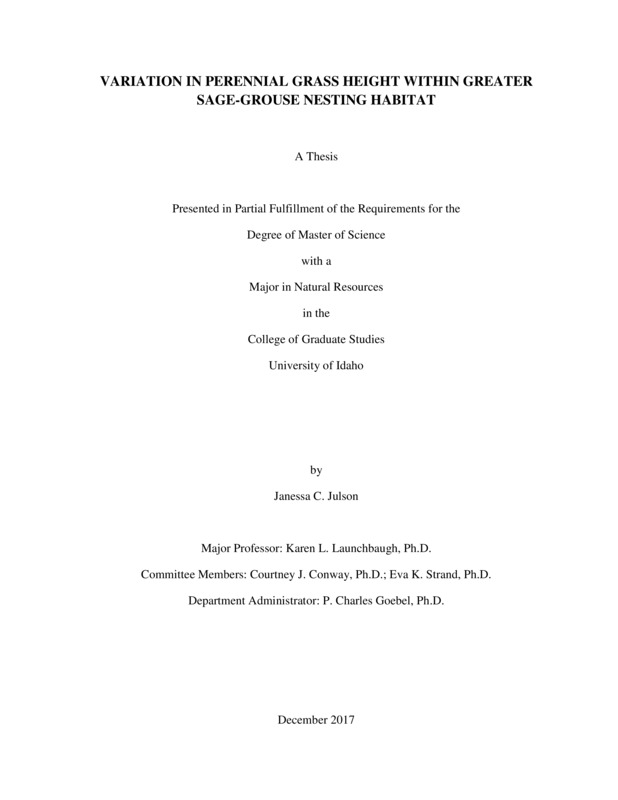VARIATION IN PERENNIAL GRASS HEIGHT WITHIN GREATER SAGE-GROUSE NESTING HABITAT
Julson, Janessa Chew. (2017-12). VARIATION IN PERENNIAL GRASS HEIGHT WITHIN GREATER SAGE-GROUSE NESTING HABITAT. Theses and Dissertations Collection, University of Idaho Library Digital Collections. https://www.lib.uidaho.edu/digital/etd/items/julson_idaho_0089n_11278.html
- Title:
- VARIATION IN PERENNIAL GRASS HEIGHT WITHIN GREATER SAGE-GROUSE NESTING HABITAT
- Author:
- Julson, Janessa Chew
- Date:
- 2017-12
- Program:
- Natural Resources
- Subject Category:
- Range management; Natural resource management
- Abstract:
-
A recent focus on sagebrush obligate species has increased the need to understand sagebrush steppe habitat for rangeland and wildlife management. Plant community attributes, such as perennial grass height, are influencing many decisions by land management agencies throughout sagebrush ecosystems, specifically those where greater sage-grouse (Centrocercus urophasianus) reside during their nesting season. In Chapter 1, our objective was to review published research to summarize and compare reported grass heights in sage-grouse nesting habitat between nest sites and available habitat, and between successful and failed nests. In Chapter 2, we assessed three types of perennial grass height in sagebrush steppe communities across four study locations in the Snake River Plains of southern Idaho. The results from both studies indicate variations of heights among grasses and metrics used in ongoing and published research. In our research in southern Idaho, we found that grass heights differed among species, and within species grass height differed among locations, ecological sites, and between years. Our results corroborate other studies that have reported that grass height differs among species and varies both spatially and temporally. This inherent variation should be taken into account when interpreting sage-grouse habitat studies and using results of such studies to set grazing and land-use policies. Our results can provide useful insight to land agencies that are developing management plans, especially those that include thresholds for grass height that are intended to benefit sagebrush obligate species, such as the greater sage-grouse. Given the spatial and temporal variation in grass heights, having a “blanket” grass height requirement across multiple geographic regions may not achieve management goals in areas where sage-grouse nesting occurs. While vegetation structure is important for nest concealment in sage-grouse nesting habitat, land management agencies should consider the extent to which grass height varies across years, in periods of extreme weather conditions, and across geographic locations.
- Description:
- masters, M.S., Natural Resources -- University of Idaho - College of Graduate Studies, 2017-12
- Major Professor:
- Launchbaugh, Karen L
- Committee:
- Conway, Courtney J; Strand, Eva K
- Defense Date:
- 2017-12
- Identifier:
- Julson_idaho_0089N_11278
- Type:
- Text
- Format Original:
- Format:
- application/pdf
- Rights:
- In Copyright - Educational Use Permitted. For more information, please contact University of Idaho Library Special Collections and Archives Department at libspec@uidaho.edu.
- Standardized Rights:
- http://rightsstatements.org/vocab/InC-EDU/1.0/

